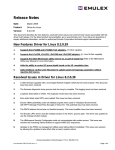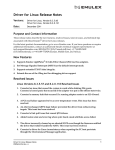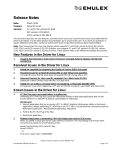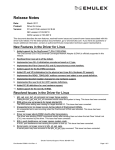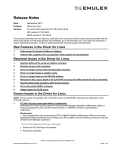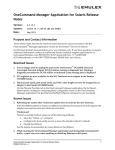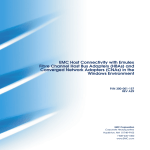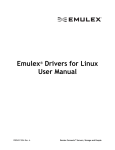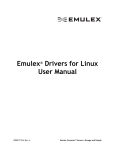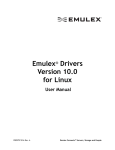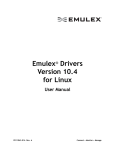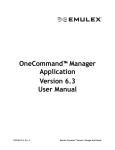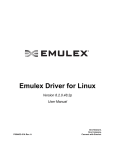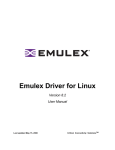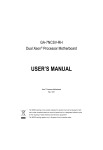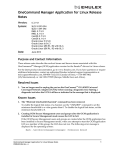Download Release Notes
Transcript
Release Notes Date: Product: Version: January 2010 Driver for Linux FC and FCoE version 8.2.0.63 NIC version 2.101.374.0 iSCSI version 2.101.374.0 This document describes the new features, resolved known issues and current known issues associated with this driver build release. For the latest product documentation, go to www.Emulex.com. If you have any questions or require additional information, contact an authorized Emulex Corporation technical support representative. New Features in the Driver for Linux 1. Supports the OCe1010x OneConnect Universal Converged Network Adapters (CNAs). 2. Supports the OneCommand Manager application version 5.0. Refer to the OneCommand Manager application User Manual for more information. 3. Adds PCI ID support for the LPSe12002-ML1-E EmulexSecure Fibre Channel Adapter. 4. Adds support for Advanced Error Reporting (AER) for PCIe HBAs. Resolved Issues in the Driver for Linux 1. Multipath Package Issues Fixed Corrected issues with the multipath package functions with the OneConnect UCNA. 2. FCF Failures Addressed Resolved various FCF failures. 3. Corrected Adapter Reset Corrected adapter reset and offline/online stress test failing with I/O errors. 4. Multiple Spurious Interrupts Corrected Required OneConnect UCNA to set up and use single FCP EQ only under INTx interrupt mode. Changed lpfc_use_msi module parameter to use INTx mode (not MSI) by default. This prevents multiple spurious interrupts from the firmware. 5. Extended Error Handling Issue Resolved Blocked all SCSI I/O requests from the midlayer until target rediscovery during Extended Error Handling EEH. 6. VPort Log Out Issue Corrected Corrected an issue that prevented a VPort to log out if deleted. 7. mbox sysfs Attribute Corrected Corrected an issue that resulted in the mbox sysfs attribute smaller than the mailbox extension size. 8. LUN Panic Fixed Fixed a potential panic if LUNs were unmapped. 9. CPU Lockup Fixed Resolved an issue that caused the CPU to lock up or hang during boot when authentication is enabled (fcauthd process is started). 10. Hot Plug Issue Resolved Fixed a potential system panic issue during PCI Hot Plug. Emulex Technical Support / Phone: 800-854-7112 Part Number P004433-02A Rev. A Page 1 of 4 11. List Corruption Fixed Corrected an issue that caused a list corruption while unloading the driver. 12. Fabric Login Issue Fixed Resolved an issue that caused the frame to be zeroed on the wire after a fabric login FLOGI . 13. Advanced Error Reporting Issue Resolved Added logic to stop and abort all I/Os on an HBA for an advanced error reporting (AER) uncorrectable non-fatal error handling. 14. AER sysfs entry Point Changed Made the AER sysfs entry point return "Operation not permitted" for OneConnect UCNAs. 15. Unsolicited CT Exchange Sequences Fixed Fixed handling of unsolicited CT exchange sequences. 16. Clear Virtual Link Support Added Added support for Clear Virtual Link command. 17. devloss Timeout Issue Fixed Corrected a devloss timeout issue when multiple initiators were in the same zone. Known Issues in the Driver for Linux 1. PCI Hot Plug may cause applications to malfunction. Performing a PCI Hot Plug may cause the HBAnyware utilities or third party applications that use the Emulex libraries (i.e. HBAAPI) to behave unpredictably or malfunction. Workaround: 1. Stop all applications that are accessing LPFC's HBAAPI interface (HBAnyware utilities or third party applications) before performing PCI Hot Plug of an LPFC HBA. Use the following command to stop the HBAnyware application: #/usr/sbin/hbanyware/stop_hbanyware 2. Perform the PCI Hot Plug of the HBA. 3. Restart the application. 2. Deleting virtual ports or performing a PCI Hot Unplug may result in SCSI errors. When you delete a virtual port via the sysfs interface or perform a PCI Hot Unplug of an Emulex HBA, the kernel may report one of the following errors: kernel: Synchronizing SCSI cache for disk kernel: FAILED or SCSI error: return code = 0x00010000. Workaround: These messages do not indicate a functional failure and can be ignored. 3. 4. Issue with the LPFC module order in the INITRD_MODULES list. On the SLES10 SP1 system, if another SCSI driver such as aic79xx, is loaded immediately after the LPFC driver through the initrd image, an interruption might occur in the SCSI mid-layer discovery process on the LUNs connected to LPFC’s Fibre Channel. This interruption can prevent the release of the SCSI discovery reference count and the LPFC driver cannot unload. Workaround: Do not add SCSI drivers immediately after the LPFC module in the INITRD_MODULES list. The “Suspend to Disk and Resume Support” feature is not supported in the LPFC driver. If you attempt to suspend to disk using the command “#echo disk > /sys/power/state”, the LPFC driver encounters a kernel Oops. Emulex Technical Support / Phone: 800-854-7112 Part Number P004433-02A Rev. A Page 2 of 4 Workaround: There is no workaround at this time. The sysfs parameter "/sys/power/state" is used to suspend and resume the system. The LPFC driver does not support this sysfs parameter. Do not attempt to use this sysfs parameter when the LPFC driver is loaded. 5. Deleted virtual ports may appear to be mounted, but are inaccessible. While Emulex provides management utilities to enable you to delete virtual ports, the LPFC driver cannot detect whether devices accessed through a virtual port are in use. You can delete a virtual port even when devices accessible through the virtual port are mounted or when I/O is outstanding to the device. If file systems are mounted on a virtual port and that virtual port is deleted, the file systems still appear to be mounted but are not be accessible. Workaround: Before deleting virtual ports, prepare the system affected by unmounting all the devices accessible through the virtual ports, and verifying that there is no outstanding I/O. 6. 4 Gb/s HBAs in virtualized environments that use Direct I/O or SFPT do not Initialize. Default driver configuration fails to initialize 4 Gb/s HBAs in virtualized environments that use Direct I/O or SFPT(Storage Fixed Pass through) .This may result in a system hang or uninitialized LPFC HBA in Intel VT-d and AMD-V IOMMU systems. Workaround: Load the LPFC driver with the following driver parameters set: lpfc_hostmem_hgp=1 lpfc_sli_mode=2 For example: # modprobe lpfc lpfc_hostmem=1 lpfc_sli_mode=2 Note: A side effect of this workaround is that virtual ports are no longer be supported by the LPFC driver when lpfc_sli_mode is set to 2. 7. Potential error messages when removing the driver kit. The driver kit removal process uses the "lpfc-install -u" command. The previous in-box LPFC driver version was saved as part of the driver kit install process. The "lpfc-install -u" restores and activates the in-box LPFC driver. However, the driver kit uninstallation process does not remove any entries in the Linux distribution configuration file (modprobe.conf). As such, parameters that would have been valid for the just-removed driver version and entered in the modprobe.conf file, are also used to load the justrestored in-box driver version. This can create problems if these two conditions exist: • The just-removed driver version includes module parameters that did not exist in the older justrestored driver version, and • One or more of these module parameters are included in the configuration file (modprobe.conf). Errors appear similar to the following: Loading LPFC Driver .FATAL: Error inserting lpfc (/lib/modules/<kernel_revision>/kernel/drivers/scsi/lpfc/lpfc.ko): Unknown symbol in module, or unknown parameter (see dmesg) Workaround: Remove all entries in the Linux configuration file (modprobe.conf) that list the LPFC driver module parameters, that is entries that begin with: options lpfc ... Then uninstall the driver kit. Note: To find the module parameters supported by a LPFC driver module, run the following command: # modinfo <driver_dir>/lpfc.ko 8. LPe12000 HBA may be identified as an "Unknown Device". On RHEL5 and SLES10-SP1 distribution kernels, the output of the Linux distribution lspci utility incorrectly identifies the LPe12000 HBA as an "Unknown device". Emulex Technical Support / Phone: 800-854-7112 Part Number P004433-02A Rev. A Page 3 of 4 Example: 0b:00.0 Fibre Channel: Emulex Corporation Unknown device f100 (rev 01) 9. Workaround: There is no workaround at this time. The Linux distribution lspci utility on RHEL5 and SLES10-SP1 distribution kernels do not yet recognize the LPe12000 HBA. A RHEL5 (U4) driver does not load from driver disk, consequently, the iSCSI boot devices do not present to install the OS. Workaround: 1. 2. 3. 4. 5. 6. 7. 8. 9. 10. 11. 12. 13. Create a driver disk (floppy) (see the Boot Manual for Emulex Adapters for more information). Create an iSCSI boot device from the BIOS (see the Boot Manual for Emulex Adapters for more information). Boot with the Linux installation CD. At the boot prompt, type: linux dd When prompted, “Do you have a driver disk?” click Yes. When prompted, insert the floppy disk and click OK. Notice the floppy is being read, but pressing <Alt> <F3> will not show be2iscsi driver being loaded. Press <Alt> <F1> and return to the main install screen. When prompted, “More driver disks?” click Yes. When prompted, “Do you have a driver disk?” click Yes. When prompted, insert the floppy disk and click OK. The following error is displayed: “No devices of appropriate type were found on this driver disk.” When prompted, select Manually choose (this is the default) and click OK. Select ServerEngines BladeEngine 2 iSCSI Initiator (be2iscsi) from the list and click OK. Press <Alt> < F3> to show the iscsi driver being loaded. Press <Alt> <F1> to return to the main install screen. When prompted, “Anymore driver disks?” Click No. You can now select the iSCSI device to install the OS. Copyright © 2003-2010 Emulex. All rights reserved worldwide. No part of this document may be reproduced by any means or translated to any electronic medium without the prior written consent of Emulex. Information furnished by Emulex is believed to be accurate and reliable. However, no responsibility is assumed by Emulex for its use; or for any infringements of patents or other rights of third parties which may result from its use. No license is granted by implication or otherwise under any patent, copyright or related rights of Emulex. Emulex, the Emulex logo, AutoPilot Installer, AutoPilot Manager, BlockGuard, Connectivity Continuum, Convergenomics, Emulex Connect, Emulex Secure, EZPilot, FibreSpy, HBAnyware, InSpeed, LightPulse, MultiPulse, OneCommand, OneConnect, One Network. One Company., SBOD, SLI, and VEngine are trademarks of Emulex. All other brand or product names referenced herein are trademarks or registered trademarks of their respective companies or organizations. Emulex provides this manual “as is” without any warranty of any kind, either expressed or implied, including but not limited to the implied warranties of merchantability or fitness for a particular purpose. Emulex may make improvements and changes to the product described in this manual at any time and without any notice. Emulex assumes no responsibility for its use, nor for any infringements of patents or other rights of third parties that may result. Periodic changes are made to information contained herein; although these changes will be incorporated into new editions of this manual, Emulex disclaims any undertaking to give notice of such changes. Emulex, 3333 Susan Street Costa Mesa, CA 92626 Emulex Technical Support / Phone: 800-854-7112 Part Number P004433-02A Rev. A Page 4 of 4




